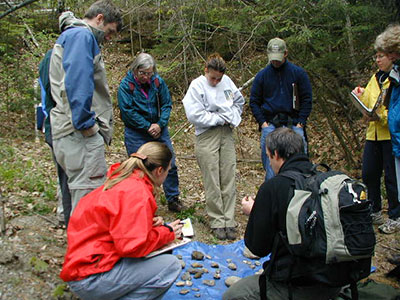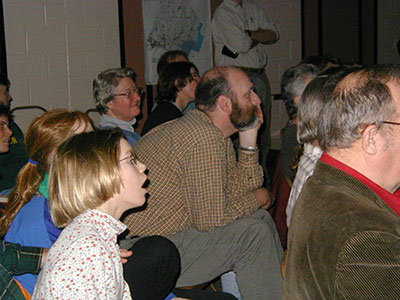The Landscape Analysis stage of PLACE is a connecting framework for the whole program. On its own, it offers community members a new, detailed look at the landscape they call home, and can invigorate an interest in the future state of that landscape.  In conjunction with other components, it becomes the foundation for place-based education curricula in local schools; provides the information taught in community education events; and shows where the town has been, helping people to understand what choices they can make as a town in the future.
In conjunction with other components, it becomes the foundation for place-based education curricula in local schools; provides the information taught in community education events; and shows where the town has been, helping people to understand what choices they can make as a town in the future.
This process typically begins with UVM graduate students and faculty conducting background research on a town landscape using an integrative framework approach, which emphasizes the intersection of natural and cultural history. These PLACE staff members draw from UVM historical archives, town archives, and state map/aerial photo collections in order to gather multiple sources of historical information into one place. (See the Analyze Your Town section for more information on this process.) Additionally, local community members are invited to share their knowledge of their town’s natural landscape and human history. These townspeople are encouraged to participate in the process of analyzing the natural features around their homes, schools, farms and businesses. Community members can be crucial to this stage of engagement; they drive the questions, provide local expertise, participate in the research itself, own the data, and can help interpret and present it to the rest of the community. The bedrock, soils, water, vegetation, wildlife, climate, and human infrastructure of the town are all documented, and the patterns and relationships between them are emphasized. Finally, these individual stories are woven into the wider town story and provide the all-important human element that helps determine a town’s individual identity.
Community Education: Evening Presentation Series & Field Trips
 Coming together to tell the story of a town landscape is a powerful way for people to reconnect with each other, and the creation of a cohesive story is an effective way to maintain or strengthen town identity. This process of community sharing and education also aims to provide people with a common foundation of knowledge and understanding on which to base community development decisions, and encourage greater enthusiasm for participation in town-level visioning processes. Typically, PLACE staff and local community members collaborate to organize and present a series of public evening presentations and corresponding weekend field trips that tell the story of the town and encourage additional sharing of the research carried out in the initial community research phase. These events are designed to be fun, but also serve to provide the public with a more comprehensive understanding of their community and landscape than they may ever have had before. They also provide rich opportunities for community building and social networking among a wide array of various stakeholders: teachers, town leaders, old-timers and newcomers – all of whom become more informed and invested citizens as a result of the PLACE educational series.
Coming together to tell the story of a town landscape is a powerful way for people to reconnect with each other, and the creation of a cohesive story is an effective way to maintain or strengthen town identity. This process of community sharing and education also aims to provide people with a common foundation of knowledge and understanding on which to base community development decisions, and encourage greater enthusiasm for participation in town-level visioning processes. Typically, PLACE staff and local community members collaborate to organize and present a series of public evening presentations and corresponding weekend field trips that tell the story of the town and encourage additional sharing of the research carried out in the initial community research phase. These events are designed to be fun, but also serve to provide the public with a more comprehensive understanding of their community and landscape than they may ever have had before. They also provide rich opportunities for community building and social networking among a wide array of various stakeholders: teachers, town leaders, old-timers and newcomers – all of whom become more informed and invested citizens as a result of the PLACE educational series.
Case Study
Community Education in Putney, VT
After conducting a comprehensive landscape analysis of the Putney community, integrating local experts’ knowledge, the project coordinator, Claire Dacey, worked with an assemblage of volunteer core members to plan community education events. She gathered the core team’s perspectives on particular issues to be covered that were critical to the community, local experts who would be good candidates as speakers, and local interpretive or stewardship efforts that would be showcased. Based on their responses, she set out to contact the individuals they had identified, solicit their involvement, and integrate the contributions of those who were interested in participating.
Claire wrote of her involvement:
My goal was to create the spine of the community presentations – providing a structure and context for the contributions of core team members and local experts, providing ample connections between the three main topics (geologic landscape, cultural landscape, and ecological landscape), and creating a story-line that would help engage audiences… Community feedback and attendance indicate that the events…were very successful. All of the educational presentations were attended by between 50 and 85 community members – a core team member in Putney remarked that the community had never before had such large turn-outs for educational programming.
Putney Community Education Events
The section below lists the events that took place in Putney, and discusses the ways in which local knowledge, expertise, and efforts were integrated and showcased.
- Presentation: “Water and Stone: foundations of Putney.” Presented by Claire Dacey with Liz Royer of the Vermont Rural Water Association; showcasing the research of core team member Ann Kerrey.
- Geology Field Walk: Led by local geologist, John Warren.
- History Open House: This was a several-hour event preceding our cultural history presentation, and featured selections from the Putney Historical Society’s collection of artifacts, educational displays designed by historical society members, and showcased oral histories collected by the newly formed Oral History Project.
- Presentation: “Shaped by Human Hands: Putney’s cultural landscape.” Presented by Claire Dacey with introduction by the Putney Historical Society regarding their activities, and featuring core team member.
- Steve Bachler sharing his work on historic mills of Putney.
- Presentation: “Our Wild Neighbors: Putney’s ecological landscape.” Presented by Claire Dacey and Chris Nytch. Showcasing the work of the Putney Mountain Association’s vernal pool monitoring project.
- Ecology Field Walk. Led by Chris Nytch, then a UVM graduate student, at the Putney Central School Forest.
 In conjunction with other components, it becomes the foundation for place-based education curricula in local schools; provides the information taught in community education events; and shows where the town has been, helping people to understand what choices they can make as a town in the future.
In conjunction with other components, it becomes the foundation for place-based education curricula in local schools; provides the information taught in community education events; and shows where the town has been, helping people to understand what choices they can make as a town in the future. Coming together to tell the story of a town landscape is a powerful way for people to reconnect with each other, and the creation of a cohesive story is an effective way to maintain or strengthen town identity. This process of community sharing and education also aims to provide people with a common foundation of knowledge and understanding on which to base community development decisions, and encourage greater enthusiasm for participation in town-level visioning processes. Typically, PLACE staff and local community members collaborate to organize and present a series of public evening presentations and corresponding weekend field trips that tell the story of the town and encourage additional sharing of the research carried out in the initial community research phase. These events are designed to be fun, but also serve to provide the public with a more comprehensive understanding of their community and landscape than they may ever have had before. They also provide rich opportunities for community building and social networking among a wide array of various stakeholders: teachers, town leaders, old-timers and newcomers – all of whom become more informed and invested citizens as a result of the PLACE educational series.
Coming together to tell the story of a town landscape is a powerful way for people to reconnect with each other, and the creation of a cohesive story is an effective way to maintain or strengthen town identity. This process of community sharing and education also aims to provide people with a common foundation of knowledge and understanding on which to base community development decisions, and encourage greater enthusiasm for participation in town-level visioning processes. Typically, PLACE staff and local community members collaborate to organize and present a series of public evening presentations and corresponding weekend field trips that tell the story of the town and encourage additional sharing of the research carried out in the initial community research phase. These events are designed to be fun, but also serve to provide the public with a more comprehensive understanding of their community and landscape than they may ever have had before. They also provide rich opportunities for community building and social networking among a wide array of various stakeholders: teachers, town leaders, old-timers and newcomers – all of whom become more informed and invested citizens as a result of the PLACE educational series.